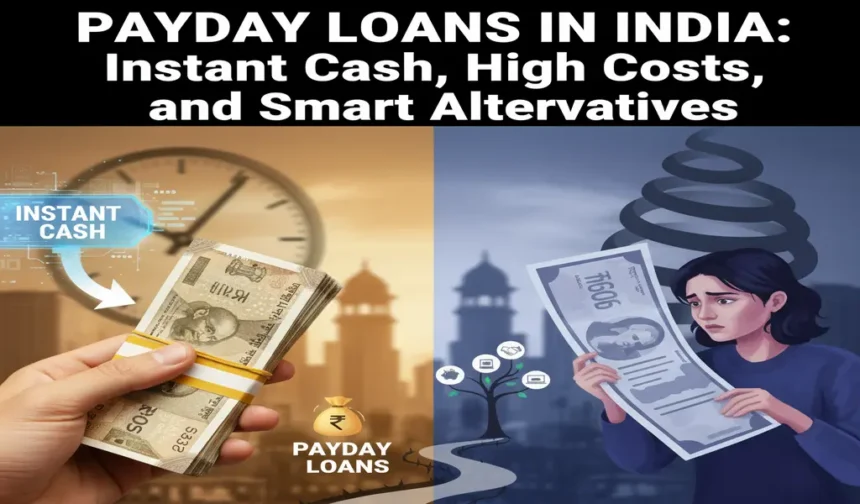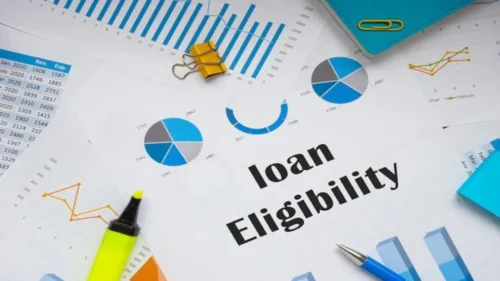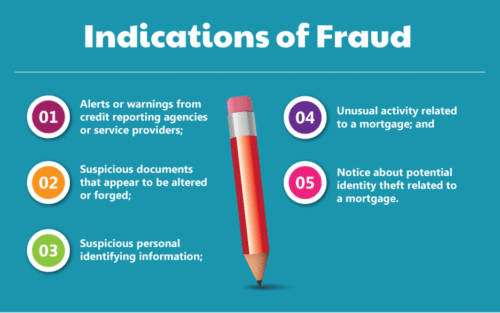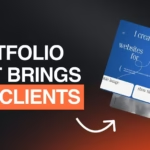Money runs short before payday. Bills pile up and stress grows. Payday loans in India promise fast help. Approval can be quick and smooth. Costs can be high and painful.
Small fees stack up over days. Debt can spill into next month. This guide shows real numbers. You get clear steps and checks. You see safer choices that work.
Understand payday loans in India. See real costs, rules, risks, and safer options. Learn approval steps, repayment terms, and data-backed case studies.
What Are Payday Loans in India?
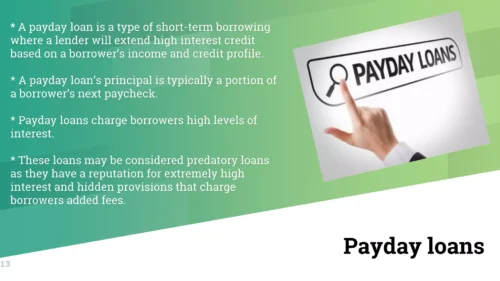
Payday loans in India are short-term borrowing. They target emergency cash loans for urgent needs. Amounts are small and quick to disburse.
Tenure ranges from 7 to 90 days. Most offers come through apps and sites. Many work with NBFC partners to fund loans.
Lenders push instant loan approval to attract users. These are high-interest payday advances by design. Repayment terms are tight and strict.
You pay on payday or within a month. Missed dates trigger more charges fast.
How They Work
You install an app or visit a site. You submit PAN, Aadhaar, and bank details. OTP verifies your phone or email. You upload bank statements and payslips.
Document requirements for loans can vary. The lender checks your borrower credit score.
Some use bank flow scoring and alternate data. Many approve within minutes for repeat users. Funds reach your bank in hours or a day.
The loan repayment period is short and firm. Auto-debit pulls money on the due date. Missed payments bring late fees and bounce charges.
Key Terms
Processing fee is the upfront charge. Interest rate is the monthly rate on the balance. APR shows the yearly cost with all fees. Late fee applies after the due date.
Bounce charge hits after a failed auto-debit. Renewal fee applies during rollovers. Tenure is your loan repayment period. Foreclosure is an early closure. The Key Fact Sheet lists all charges.
The Core Problem
Cash gaps push rushed choices. Speed hides true loan costs. Fees look small but grow fast. Net disbursed cash is lower than principal. APR reveals the real price.
Repeat loans trap future income. Rollovers drag debt forward. Contact scraping risks privacy. Harsh recovery calls can happen with shady apps. Budget stress worsens if income dips next month.
Case Study 1: 10,000 Rupee Loan, 30 Days
Ravi is 27 and delivers food. He needs money for a medical bill. He takes 10,000 for 30 days. The processing fee is 800. GST on the fee is 144.
The app sends 9,056 to his bank. The stated monthly rate is 3 percent. Interest for 30 days is 300. He pays back 10,300 at day 30.
On paper, the cost is 1,244. The effective 30-day cost on 9,056 is 13.7 percent. The annualized APR is very high on that base. This pattern is common with small cash loan providers.
Lessons From Case 1
APR matters more than the headline rate. Fees apply to the full principal. Net cash in hand is less than the principal.
Short spans make fees look big. Review fees and interest rates together. Ask for the Key Fact Sheet before consent. Compare online payday lending offers by APR.
Regulatory Environment in India
RBI issued digital lending rules in 2022. Lenders must show a Key Fact Sheet. All charges must be disclosed upfront. Money must go straight into your bank account.
Pool accounts are not allowed now. Auto-debit mandates must be clear and revocable. Apps need consent for any data access.
Cooling-off periods allow easy exits. Recovery must follow fair conduct codes. Unregistered apps carry high risk.
Read updates on the RBI site to stay current.
External resources:
- RBI Digital Lending Guidelines: https://m.rbi.org.in/Scripts/NotificationUser.aspx?Id=12304
- RBI CMS complaints: https://cms.rbi.org.in
- RBI FAQs on digital lending: https://rbi.org.in/Scripts/FAQView.aspx?Id=139
- MeitY actions on illegal apps: https://www.meity.gov.in
Who Can Lend
Banks offer small personal loans and overdrafts. NBFCs issue small loans with faster processes. Apps often act as front-end partners. Many apps route underwriting to NBFCs. Some apps operate outside rules. Always verify the NBFC on the RBI list.
Loan Eligibility Criteria
Most lenders want ages 21 to 58. PAN and Aadhaar handle KYC checks. They ask for salary slips or bank statements. Many want three to six months of statements.
A borrower credit score above 650 helps. Lower debt to income improves approval odds. Address proof can be Aadhaar or a utility bill. Your employer or gig platform details may be checked.
Document Requirements for Loans
Submit PAN and Aadhaar. Share a selfie for KYC. Upload bank statements. Add salary slips if salaried. Share GST data or invoices if self-employed. Sign an e-mandate for auto-debit. Review the Key Fact Sheet carefully.
Fees and Interest Rates
Processing fees often range from 2 to 10 percent. GST applies to the processing fee. Monthly interest can be 2 to 4 percent. Late fees can be 200 to 1,000 per miss. Bounce charges add to the total cost.
Renewal fees raise costs during rollovers. Insurance add-ons can slip into the pack. Remove add-ons you do not need. Ask for total rupee cost, not only rates. Read the Key Fact Sheet line by line.
Repayment Terms That Hurt
Tenure can be 7, 14, 30, or 90 days. Some loans use weekly or biweekly EMIs. Many use a bullet payment at the end. Auto-debit pulls funds on the due date.
One miss triggers a chain of charges. Rollovers extend tenure at a price. Repeat loans stack costs across months. Budgets get tight after each payday.
Risks You Must Consider
High-interest payday advances drain cash. Hidden fees may sit in fine print. Data misuse risks exist with shady apps. Contact scraping can be used to shame.
Threat calls can happen with illegal apps. Missed dues damage your credit score. Collection costs may be added to dues. Legal notices create pressure and stress. Fraud apps may vanish with your data.
Helpful links:
- NPCI e-mandate info: https://www.npci.org.in
- Moneylife reports: https://www.moneylife.in
Red Flags During the Loan Application Process
No NBFC partner is named on the site. No Key Fact Sheet is shared before consent. No customer care or address is listed. The app asks for contacts or gallery access. Terms hide renewal or prepayment fees. Claims say zero cost loans with no fees. Typos and wrong legal names appear. No RBI registration number is listed.
Better Options Than Payday Loans in India
Ask HR for a salary advance. Use a bank overdraft for short gaps. Try a credit union if you have access. Use a secured loan against a deposit.
Ask family for a small loan with clear terms. Sell a spare device for quick cash. Negotiate a payment plan with the biller. Use BNPL only for essentials. Try microfinance if you qualify.
How To Ask HR For a Salary Advance
Explain the urgent need in one line. State the amount and the payback date. Offer to repay in the next payroll. Ask for a written approval by email. Keep the terms simple and clear.
Case Study 2: Rollover Trap Doubles Costs
Priya is 25 and works in support. She needs her laptop repaired to work. She borrows 8,000 for 30 days. The processing fee is 600. GST on the fee is 108. Disbursal is 7,292 to her bank. The monthly rate is 3 percent. Interest for 30 days is 240. Her day 30 due is 8,840.
She cannot pay on day 30. The lender adds a renewal fee of 600 plus GST 108. After 60 days, the due is 9,440. She pays 1,440 on 7,292 net cash. The two-month cost is very high. Rollovers can double costs very fast.
Lessons From Case 2
Plan for the repayment date before you apply. Keep a small buffer for the debit. Avoid rollovers unless there is no other option. If you must roll, close the loan fast after. Track the APR after each rollover.
Case Study 3: Same Rate, Different APR
Ali is 31 and works shifts. He needs rent support after a family expense.
Offer A has a 12,000 principal. The fee is 3 percent, or 360. GST on the fee is 65. The net disbursed is 11,575. The rate is 3 percent per month. Tenure is 30 days. The due is 12,360. The 30-day cost on net is 785 on 11,575, or 6.8 percent.
Offer B has a 12,000 principal. The fee is 6 percent, or 720. GST on the fee is 130. The net disbursed is 11,150. The rate is 3 percent per month. Tenure is 30 days. The due is 12,360. The 30-day cost on net is 1,210 on 11,150, or 10.9 percent.
The monthly rate is the same in both offers. The APR is higher when the fee is higher. Use APR to compare online payday lending offers.
Lessons From Case 3
Do not compare by monthly rate alone. Compare net cash against total due. Ask for a fee waiver if your profile is good. Many lenders reduce fees for repeat users. Save all screens that show fees and totals.
Loan Repayment Period and Budget Planning
Match tenure to your cash inflow. Align the due date with your salary day. Split rent or bills if the landlord agrees. Use one bank account for loan debits. Keep a 1,000 to 2,000 buffer balance. Track dues in a sheet or a notes app. Review EMI dates weekly until closure. Pause non-essentials while the loan is open.
How To Compare Lenders and Offers
Ask for the Key Fact Sheet first. Check the APR on the full cost. Compare net disbursed to the total due. Remove insurance add-ons you do not need. Read current reviews on trusted forums. Verify the NBFC on the RBI list. Avoid apps with harassment reports. Save screenshots of all pre-loan pages.
Quick APR Comparison Example
Consider a 10,000 loan for 30 days. Offer one uses a 4 percent fee and 2.5 percent rate. The fee is 400 and GST is 72. The net cash is 9,528. Interest is 250. The due is 10,250. The 30-day cost on net is 722, or 7.6 percent.
Offer two uses an 8 percent fee and the same rate. The fee is 800 and GST is 144. The net cash is 9,056. Interest is 250. The due is 10,250. The 30-day cost on net is 1,194, or 13.2 percent. Fee size drives APR on short spans.
Pay Only What You Must
Set calendar alerts three days before due. Keep a small balance cushion for auto-debit. Prepay early if the foreclosure fee is small. Avoid rollovers unless there is no other way. Do not take a new loan while one is open. Ask support for a waiver after a failed debit. Get closure confirmed in writing. Download the NOC or closure letter.
If You Are Stuck in a Debt Loop
Stop all new borrowing now. List all loans, dues, and dates today. Close the costliest loan first. Ask for a restructure with more time. File a support ticket if rules were broken.
Switch auto-debit to a safer account. Contact a credit counselor. Revoke contact access on the app. Log recovery calls that break conduct. Keep a record of all messages.
Filing Complaints and Getting Help
Write to the lender’s grievance desk. Escalate to the NBFC nodal officer. Use the RBI CMS portal if unresolved. Report illegal apps to MeitY with proof. Save emails and call logs for records. If threatened, note the number and report it.
Online Payday Lending: Data and Trends
App installs spiked during lockdowns. Many illegal apps scraped contacts. RBI and MeitY pushed store removals later. Better apps now show clear fee sheets.
Users still report hidden add-ons at times. Read recent reviews before you apply. Search forums for recovery conduct notes. Safer apps list clear addresses and NBFC names.
Build a Small Safety Fund
Start with 500 to 1,000 each month. Move it on salary day automatically. Keep it in a separate savings account. Aim first for one month of core costs.
Grow to three months when you can. Use it only for true emergencies. Refill it after each use. This reduces need for emergency cash loans.
FAQs on Payday Loans in India
Q1. Are payday loans in India legal?
Yes, if issued by banks or NBFCs. Beware of unregistered or fake apps.
Q2. What loan amounts are common?
Many range from 2,000 to 50,000 rupees. Some reach 1 lakh for strong profiles.
Q3. How fast is instant loan approval?
Some approve in minutes for repeat users. Disbursal can still take hours or a day.
Q4. What are typical fees and interest rates?
Fees can be 2 to 10 percent. Monthly interest ranges from 2 to 4 percent.
Q5. Do I need a high borrower credit score?
Scores above 650 help a lot. Some apps score bank flows over bureau data.
Q6. Can I prepay a loan?
Many allow it with a small fee. Read the foreclosure policy before you sign.
Q7. Will late payment hurt my score?
Yes, late marks can last for years. Keep due dates aligned with salary credit.
Q8. How do I spot risky apps?
No NBFC partner name is a red flag. No Key Fact Sheet is another clear warning.
Q9. What is the best repayment term?
Pick the shortest you can repay on time. Avoid rollovers by planning early.
Q10. Can I get financial hardship assistance?
Some lenders offer payment plans on request. Keep all changes in writing.
Wrap-Up
Problem: Cash gaps lead to rushed choices. Agitation: Fees stack up and strain next month. Solution: Compare APR and plan repayment early. Payday loans in India should be a last choice. Use safer options first when possible. Study the Key Fact Sheet to catch hidden costs. Build a safety fund to avoid debt loops. Know your rights under RBI digital lending rules.





